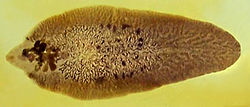- Fasciola hepatica
-
Fasciola hepatica Fasciola hepatica - adult worm Scientific classification 
Kingdom: Animalia Phylum: Platyhelminthes Class: Trematoda Order: Echinostomida Family: Fasciolidae Genus: Fasciola Species: F. hepatica Binomial name Fasciola hepatica
Linnaeus, 1758Fasciola hepatica, also known as the common liver fluke or sheep liver fluke, is a parasitic flatworm of the class Trematoda, phylum Platyhelminthes that infects the livers of various mammals, including humans. The disease caused by the fluke is called fascioliasis (also known as fasciolosis). F. hepatica is distributed worldwide, and causes great economic losses in sheep and cattle.
Habit and habitat:- Animals including dogs, deer, rabit, man, monkey are carriers of fasciola hepatica. The sheep is the main harborer of fasciola hepatica.
Contents
Life cycle
To complete its life cycle, F. hepatica requires a freshwater snail as an intermediate host, such as Galba truncatula, in which the parasite can reproduce asexually.
Species in the family Lymnaeidae that serve as naturally or experimentally intermediate hosts of Fasciola hepatica include: Austropeplea tomentosa,[1] Austropeplea ollula,[1] Austropeplea viridis,[1] Radix peregra,[1] Radix lagotis,[1] Radix auricularia,[1] Radix natalensis,[1] Radix rubiginosa,[1] Omphiscola glabra,[1] Lymnaea stagnalis,[1] Stagnicola fuscus,[1] Stagnicola palustris,[1] Stagnicola turricula,[1] Pseudosuccinea columella,[1] Lymnaea viatrix,[1] Lymnaea neotropica,[1] Fossaria bulimoides,[1] Lymnaea cubensis,[1] Lymnaea sp. from Colombia,[1] Galba truncatula,[1] Lymnaea cousini,[1] Lymnaea humilis,[1] Lymnaea diaphana,[1] Stagnicola caperata[1] and Lymnaea occulta.[1]
From the snail, minute cercariae emerge and swim through pools of water in pasture, and encyst as metacercariae on near-by vegetation. From here, the metacercariae are ingested by the ruminant, or in some cases, by humans eating uncooked foods such as watercress. Contact with low pH in the stomach causes the early immature juvenile to begin the process of excystment. In the duodenum, the parasite breaks free of the metacercariae and burrows through the intestinal lining into the peritoneal cavity. The newly excysted juvenile does not feed at this stage, but once it finds the liver parenchyma after a period of days, feeding will start. This immature stage in the liver tissue is the pathogenic stage, causing anaemia and clinical signs sometimes observed in infected animals. The parasite browses on liver tissue for a period of up to six weeks, and eventually finds its way to the bile duct, where it matures into an adult and begins to produce eggs. Up to 25,000 eggs per day per fluke can be produced, and in a light infection, up to 500,000 eggs per day can be deposited onto pasture by a single sheep.
Disease biology
In the United Kingdom, F. hepatica is a frequent cause of disease in ruminants, most commonly between March and December. Cattle and sheep are infected when they consume the infectious stage of the parasite from low-lying, marshy pasture. The effects of liver flukes are referred to as fascioliasis, and include anaemia, weight loss and submandibular oedema; diarrhoea is only an occasional consequence. Liver fluke infestation is diagnosed by yellow-brown eggs in the faeces. They are not distinguishable from the eggs of Fascioloides magna, although the eggs of F. magna are very rarely passed in sheep, goats or cattle.
A serious consequence of the liver damage caused by fascioliasis is that latent Clostridium novyi spores can be activated by the low oxygen conditions in the damaged tracts the parasite forms in the liver; this can lead to "black disease", caused by Clostridium novyi type B or immune-mediated haemolytic anaemia (IMHA) leading to haemoglobinuria caused by C. novyi type D.
Treatment
The drug of choice in the treatment of fasciolosis is triclabendazole, a member of the benzimidazole family of anthelmintics. The drug works by preventing the polymerization of the molecule tubulin into the cytoskeletal structures, microtubules. However, resistance of F. hepatica to triclabendazole has already been recorded in Australia[2] and Ireland.[3] Artemether has been shown to be effective in a rat model of fascioliasis.[4]
See also
References
- ^ a b c d e f g h i j k l m n o p q r s t u v w x y Correa C. A., Escobar J. S., Durand P., Renaud F., David P., Jarne P., Pointier J.-P. & Hurtrez-Boussès S. (2010). "Bridging gaps in the molecular phylogeny of the Lymnaeidae (Gastropoda: Pulmonata), vectors of Fascioliasis". BMC Evolutionary Biology 10: 381. doi:10.1186/1471-2148-10-381.
- ^ Overend DJ & Bowen FL (1995). "Resistance of Fasciola hepatica to triclabendazole". Austral Vet J 72 (7): 275–276. doi:10.1111/j.1751-0813.1995.tb03546.x. PMID 8534235.
- ^ Mulcahy G & Dalton JP (1998). "Vaccines in control of liver fluke infections in ruminants: current status and prospects". Irish Vet J 51: 520–525.
- ^ Keiser J, Utzinger J, Vennerstrom JL, et al. (2007). "Activity of artemether and OZ78 against triclabendazole-resistant Fasciola hepatica". Trans R Soc Trop Med Hyg 101 (12): 1219–1222. doi:10.1016/j.trstmh.2007.07.012. PMID 17905370.
Categories:- Digenea
- Animal diseases
- Veterinary helminthology
- Animals described in 1758
Wikimedia Foundation. 2010.



